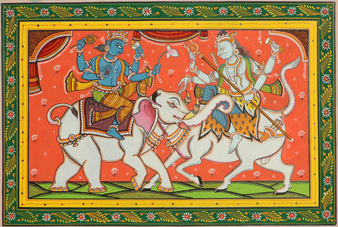 As the oldest religion still widely practiced today, Hinduism has taken different evolutionary forms where the modern devotee may be impervious to the roots or original intentions of certain philosophical works. Among the metaphysical debate has been the ranking of Shiva and Vishnu creating different sects, Shaivism and Vaishnavism, where devotees of each have attempted to clarify a hierarchical order. Stories known as Puranas, associated with each deity carry conflicting information placing a particular deity at the forefront possibly due to each sects biases. Vishnu and Shiva have each taken on conflicting ideals and seem to influence a different aspect of a devotees life. Like many other religions, Hinduism carries a trinity, or trimurti, as expressed through G-O-D, with Brahma as the (G)enerator, Vishnu as the (O)perator, and Shiva as the (D)estroyer. Brahma is considered the original patriarch of mankind, or the "Abraham" of the Hindu tradition. However, Brahma's progenitor is Vishnu where a progenitor for both Vishnu and Shiva is left ambiguous and may be simply explained as appearing from Shakti, or the feminine chaotic energy. 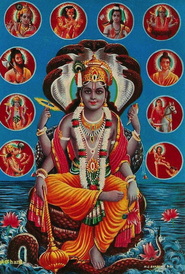 Vishnu and His Major Avatars Vishnu and His Major Avatars Possibly the most popular Hindu deity, Vishnu holds management responsibilities propitiated by devotees for assistance in earthly life. Vishnu is considered the upholder of righteousness or one's duty known as dharma within the material world. Whenever there is an influx of unrighteousness within the world, Vishnu makes an appearance within the World with his most popular avatars being Rama of the Ramayana and Krishna of the Mahabharata. Along Vishnu's side is his consort Goddess Lakshmi who appears respectively as Sita and Radha. Lakshmi being symbolic of abundance and prosperity, together they appear to express following one's dharma within the world and the ability to reap the abundance thereof. As a vedic concept, dharma is often associated with cleanliness and purity with concepts of vegetarianism and nonviolence often adopted within the Vaishnava tradition. 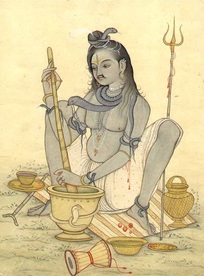 Shiva, Lord of Bhang Shiva, Lord of Bhang Another popular deity, Shiva holds drastically different qualities from Vishnu and overall Vedic/Brahamanic concepts. Especially in his association with the fierce Goddesses labelled as the Mahavidyas in the tantric tradition, Shiva seems to challenge the patriarchal structure found within the Vedas. Vishnu's consort, Lakshmi, carries submissive qualities often depicted as massaging Vishnu, whereas, Shiva can be found subdued by the Goddess and limp under her feet. Such concepts render credence to the Aryan invasion theories, where it appears that there is some sort of attempt to combine drastically different ideologies. As depicted in the Shaivaite traditions, Shiva appears to be anti-dharmic. As opposed to cleanliness and purity, Shiva holds qualities that would be despised in typical Vedic/Brahamanic worship. As opposed to the worldy management of Vishnu, Shiva is more associated with death, isolated yoga amounting to worldly renunciation, and Panchamakara which includes intoxicants, meat, and sacred fertility. 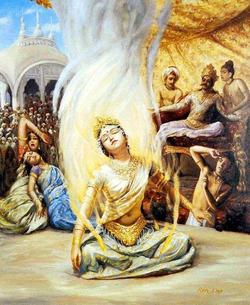 Sati Sati The contradictions are reflected within the story of his original consort Sati. Raised within the typical Vedic/Brahamanic household, Shiva's inauspicious qualities simply were not acceptable for Sati's father leading to Sati's bodily sacrifice. However, Shiva and Sati are reunited in marriage through Sati's physical incarnation as Parvati. Similar to Sati, Parvati appears to have a Vedic/Brahamanic background where she has been depicted as complaining to her mother that Shiva is often devoid of dharmic (household/worldly) duties where Shiva would much rather parlay in intoxicants and pursue ascetic yogic activities. David Kinsley, Hindu Goddesses. Unlike Vishnu whose duty is the management of righteousness with mankind, it appears Shiva needs to be appeased by the Goddess for Shiva to assist mankind.
Hence, the conflicting roles of Vishnu and Shiva are in direct opposition and can be seen as a tension. However, this tension can be described as merely duality of the same spiritual spectrum. Shiva and Vishnu thus become the proper duality, the inner world and the outer world, the spiritual world and the material world. The feminine aspects portray similar dual concepts with Lakshmi representing abundance within the outerworld, and the tantric equivalent Kamala (A Mahavidya often considered to be the same as Lakshmi) representing spiritual internal abundance. Therefore, the conflicting practices and depictions show the tension and mankind's inherit need to unite the two.
The eastern concept of duality appears to be in stark contrast to western concepts that depict duality as simple good and evil. Firstly, good and evil tend to be relative notions, opinions created by the individual. An action deemed as good may have negative consequences and vice versa. As an example, Christ's sacrifice may be seen as the ultimate sacrifice in purifying mankind, an act that many would argue is the extreme good. However, such a powerful sacrifice may stymie mankind's own ability and personal challenge to become Christs, a concept which may be seen as not good. Eastern concepts of duality stress the importance of both sides, examples being night and day, inhalation and exhalation, emotional and logical, with a balance creating harmony. Vishnu and Shiva can be seen as similar opposing poles that would instill harmony in both the spiritual and material planes.
1 Comment
|
AuthorOverly educated and continuously exploring and revealing more behind the veil. "It cannot be too highly emphasized that the mystic swims in the same waters in which the psychotic drowns."
-James Wasserman, The Mystery Traditions Archives
August 2019
Categories
All
|
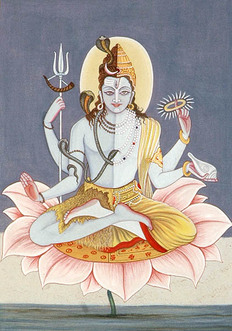
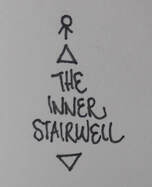
 RSS Feed
RSS Feed